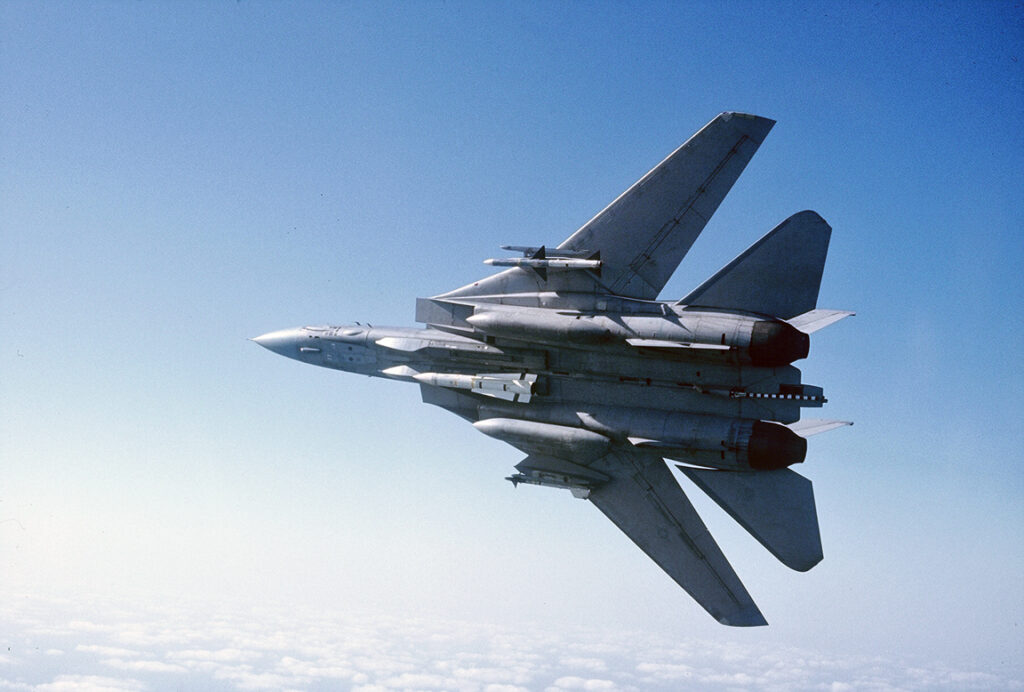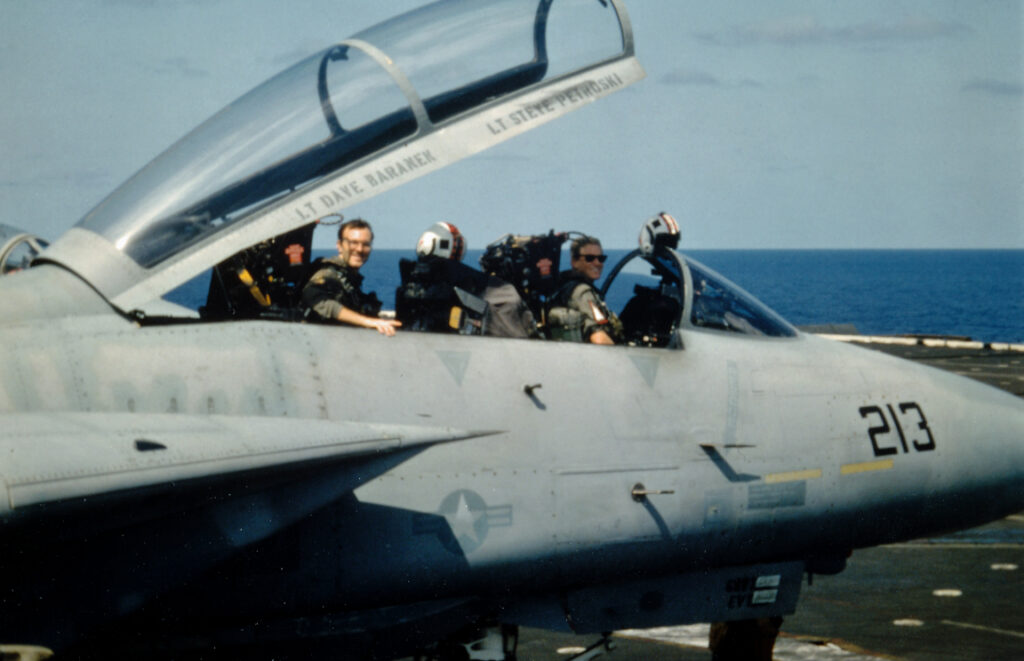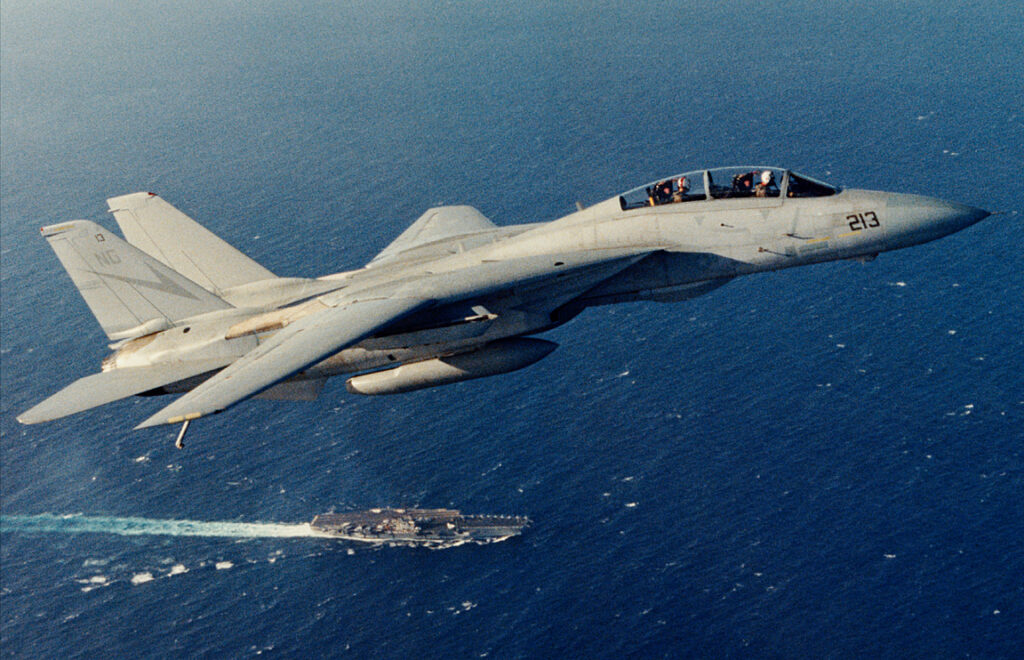“As the left engine failed and I saw the RPM tape drop to zero, I applied full right rudder”
During all phases of flight, the F-14 Tomcat was a powerful, complex, and demanding aircraft to fly. It was difficult to correctly align the aircraft with the catapult track for the cat shot when launching from an aircraft carrier, for example. This task was consistently completed by flight deck personnel and aircrews, constantly under time limitations to preserve competency that could be crucial during combat operations — an incredible feat of skill and teamwork. If there is a malfunction, the consequences might be disastrous. During my first deployment, I learned this the hard way.
This occurred on September 30, 1983. We were in the second month of deployment aboard the USS Ranger, and I was a first-tour Tomcat pilot flying F-14As with the Fighting Renegades of VF-24. We’d just sailed by Vietnam in the South China Sea, having just left the Philippines. I was supposed to go on the air in the middle of the day. Sure, practicing radar intercepts on another F-14 from our squadron would be tedious, but that was part of the deal… staying current. I was flying Tomcats from an aircraft carrier, so “boring” was a relative term. It was, after all, a beautiful day.
Briefings, pre-flights, and man-ups were all part of the routine. Lieutenant Dave “Bio” Baranek, my normal RIO, was flying with me on his second deployment with the Renegades. We got along swimmingly. As I taxied into position and connected to the catapult, we ran over the launch checklist. I went to MIL power on orders from the flight deck, executed a control wipeout, and fixed my gaze on the Shooter. My senses and brains were all geared up for the impending event. I chose Zone 5 when the signal came on (full afterburner). With the extra power, our plane rumbled. The Shooter moved his body forward in the signal to launch, clearly clearing the catapult track. The catapult fired a split second later.
The Tomcat usually oscillated somewhat when it lined with the shuttle path down the flight deck as it sped forward. On this specific occasion, the jolt was enough to rip the problematic tower shaft in the Pratt & Whitney TF30 engine on our left side, which mechanically operates the fuel control input.
There isn’t much to do during the catapult stroke until a pilot salutes the catapult officer that you’re ready to launch. I was generally fascinated by the instruments of my vertical tape engine. I engaged the full right rudder as the left engine failed and the RPM tape dropped to zero. Because the F-14’s engines are so far apart, maintaining balanced flight with an engine loss necessitates a considerable rudder input (nearly full).
When we stepped off the flight deck, the plane had settled into small yaw to the right. With the yaw and the settle, Bio began to wonder what had happened. We were lucky enough to have a hot mic, so I interrupted him and said, “We lost the left engine. I’ve got it.”
The tower informed us that our left afterburner had blown out, based on their observations. The left engine had failed, and we were now single-engine. Bio notified them of this.

Even with full fuel and a usual loadout, the F-14A could fly single-engine, as I rapidly discovered. Our aircraft was outfitted with a single AIM-54A Phoenix, two AIM-7F Sparrows, and two AIM-9L Sidewinders, as well as the two Phoenix rails and two fuselage-mounted drop tanks that we always brought with us on deployment. The settlement wasn’t horrible after we got off the deck. I didn’t even think about getting rid of things. The 9-foot space between engine centerlines was a bigger worry, as any Tomcat crew could tell you. We’d all seen the footage of a cat shot gone wrong, in which the pilot failed to keep the nose down and the plane rolled. There were two fatalities. It drew the attention of the public, leading to changes in single-engine takeoff procedures. That’s probably why I concentrated on the engine tapes. When it happened to me, I was prepared.
Our wingman joined us after we cleaned up the plane. As we accelerated to 320 KIAS, we went through the engine failure procedures and prepared for an engine start attempt. We tried a cross bleed air to start with the bleed air pressure from the operational right engine to rotate the starter for the left engine after the regular air start failed. This was ineffectual as well.
I started addressing my fuel distribution situation as part of engine failure procedures by using the fuel feed switch to choose the fuel system to feed the good engine (right side) from the inoperative left engine side. As I watched the amount of fuel on my left side decrease, I knew this function was working properly. The next phase would be to dump gasoline from our current level of 19,000 pounds to around 5,000 pounds in order to reach the maximum weight for a trap, dubbed “max trap.” The Ranger informed us that, due to our situation, they would retrieve our plane as soon as we were ready, rather than making us wait for the two-hour cycle. We anticipated dumping fuel and being on deck in 20 minutes or less.

The F-14 had a system of left and right-side fuel tanks that led to the left and right feed tanks, which supplied fuel to each engine. In the event of an engine failure, a feed tank connection valve is provided for side-to-side fuel balancing and access to fuel from the opposing side. A series of “motive flow” pumps powered by pressurized fuel carried the gasoline throughout the aircraft, transferring fuel from each system of internal fuel tanks. This notion of using gasoline from the aircraft’s engine-driven fuel pumps to power transfer pumps around the aircraft was novel, and it had just recently played a key role in a mishap involving a single-engine Tomcat that crashed three miles behind the aircraft carrier during a night approach. After the left-to-right feed tank connection failed, the tanks on the operational engine side of the F-14 ran out of fuel.
However, as I began fuel dumping to lower gross weight to the max trap, my fuel management issue became more serious. Only our operative, right-side pair of tanks were leaking fuel, and the right feed tank, which directly feeds the right engine, was no longer showing as full. It gradually dropped from 1200 pounds to 1000 pounds and then lower. I stopped gasoline dumping and noticed that we were burning gas from the top left side, despite the fact that our right engine feed tank was only around two-thirds full at 800 pounds of fuel. It was the appropriate feed tank, among all of our tanks and tubes, that kept our good engine operating. At a cautious fuel setting, 800 pounds would last roughly ten minutes. It became evident that I’d have to carefully manage my fuel distribution and weight by performing a series of short gasoline dumps followed by periods of inactivity.
Our squadron representative and Commanding Officer, who were now in the control tower aiding us by radio, chatted with Bio and me for a long time. With our onboard gasoline holding us above the maximum fuel limit, it was clear that we wouldn’t be able to board the aircraft carrier anytime soon. The Ranger was on its route to the North Arabian Sea in response to Ayatollah Khomeini’s threat to mine the Straits of Hormuz, causing a massive increase in global oil prices. We were off the coast of Vietnam, and shipboard flight operations were referred to as “Blue Water Ops,” which meant that, despite the availability of landing fields in neighboring countries, the ship was the intended point of landing, except in the most extreme cases, such as arresting hook separation or other highly unusual calamities. The fact that it was a single-engine aircraft did not qualify it for a divert to a different aircraft.
The right feed tank gradually depleted to roughly 600 pounds of fuel as the practice of short dumps and burning fuel from the right side of the plane proceeded. The operational engine side-feed tank was always full while we conducted single-engine operations and approaches in the simulator. With my current situation, I was concerned that in the event of a wave-off or bolter (missing arresting wire), we’d need an afterburner to accelerate and climb even with our gear on. With the afterburner (each engine) burning at 1000 pounds per minute, there was little room for error as the operating, right-side feed tank plummeted below 500 pounds. Bio and I opted to head towards the ship for an overweight landing despite being above the maximum trap due to remaining fuel. When I asked Bio about it later, he said he “figured they built in a fudge factor” when they made the decision.

About ten miles behind Ranger, we dipped to 600 feet and reduced to gear and flap speed. The Air Boss gave us the indication that the deck was ready and the LSO (landing safety officer) was standing by as we neared the ship. He told us that in the event of a wave-off or bolter, we should rapidly gather our kit and exit the afterburner. I was concerned as well, with just 400 pounds showing in my right feed tank.
We employed ACLS needles to aid us to fly the approach to the ship as we did at night or in adverse weather, aligning our flight path with that of the ship. At this speed, I needed a lot of rudder trim to correct for thrust asymmetry, and our jet was cocked roughly 15 degrees to fly straight ahead. The view of the ship through the left front window instead of the front canopy bow would have been highly disorienting at night, so I was grateful for decent visibility during daylight. We took a methodical approach. As we experienced turbulence or the “burble” from the Ranger’s superstructure, I increased the power by a squirt. As we reached the ramp, the LSO cautioned, “Don’t settle” and “Just a little back off.” I was concerned that our cocked-right attitude would diminish the hook’s chances of engaging with the target.
After 1.5 hours of flight time, the trauma was finally over. We deplaned and were greeted by maintenance personnel and our Commanding Officer after shutting down our engine and being choked and roped down to the flight deck. With his arm around my shoulders, he inquired whether, during the acceleration of the catapult stroke, I had allowed the left engine throttle to roll back to idle, felt embarrassed, and used the engine failure as a cover tale. I believe he saw my willingness to let my RIO Bio handle the radio signals for the majority of the event as a sign of weakness on my behalf. Even though the RIO has the main communications power in the F-14, I learned to be more assertive on the radios after that.
After starting the engine to troubleshoot, maintenance technicians instantly noticed that something was seriously wrong. The engine spun considerably past its typical rpm almost instantly without the mechanical strain carried by the tower shaft. The CO apologized to me, the LSO gave me an “OK – no comment” landing grade, and Bio and I were named Pacific Commander Naval Air Forces Pros of the Week. As I continued my career in the F-14, I took the squadron training briefings on single-engine and fuel systems like my own, grateful for daylight, good weather, and good luck that day off the coast of Vietnam in 1983.
Finally, upon reading my logbook for this post, I discovered that my aircraft number for that day was 160888. Cross-referencing it with our squadron’s aircraft, I discovered that it was NG213, the plane with my name and bios painted on the canopy rails!
Check out Bio’s website, www.topgunbio.com, and his book TOPGUN DAYS for additional information about the F-14 Tomcat.
THE FACTS
– Date: Sep. 30, 1983
– Location: USS Ranger (CV-61), South China Sea
– Squadron: VF-24
– BuNo: 160888
– Modex: NG213
– Names: Pilot: LT STEVE PETROSKI, RIO: LT DAVE BARANEK
– Weapon Load: 1 x AIM-5A, 2 x AIM-7F, 2 x AIM-9L, 2 x External Tanks

Photo by Dave “Bio” Baranek

